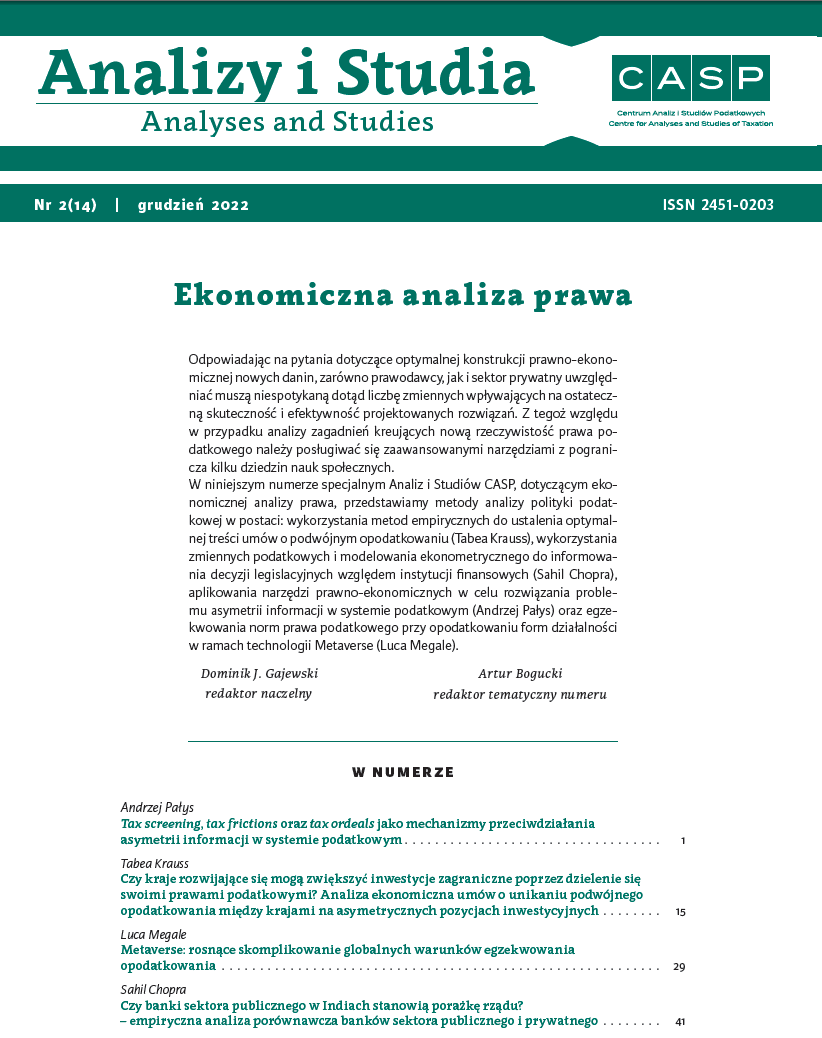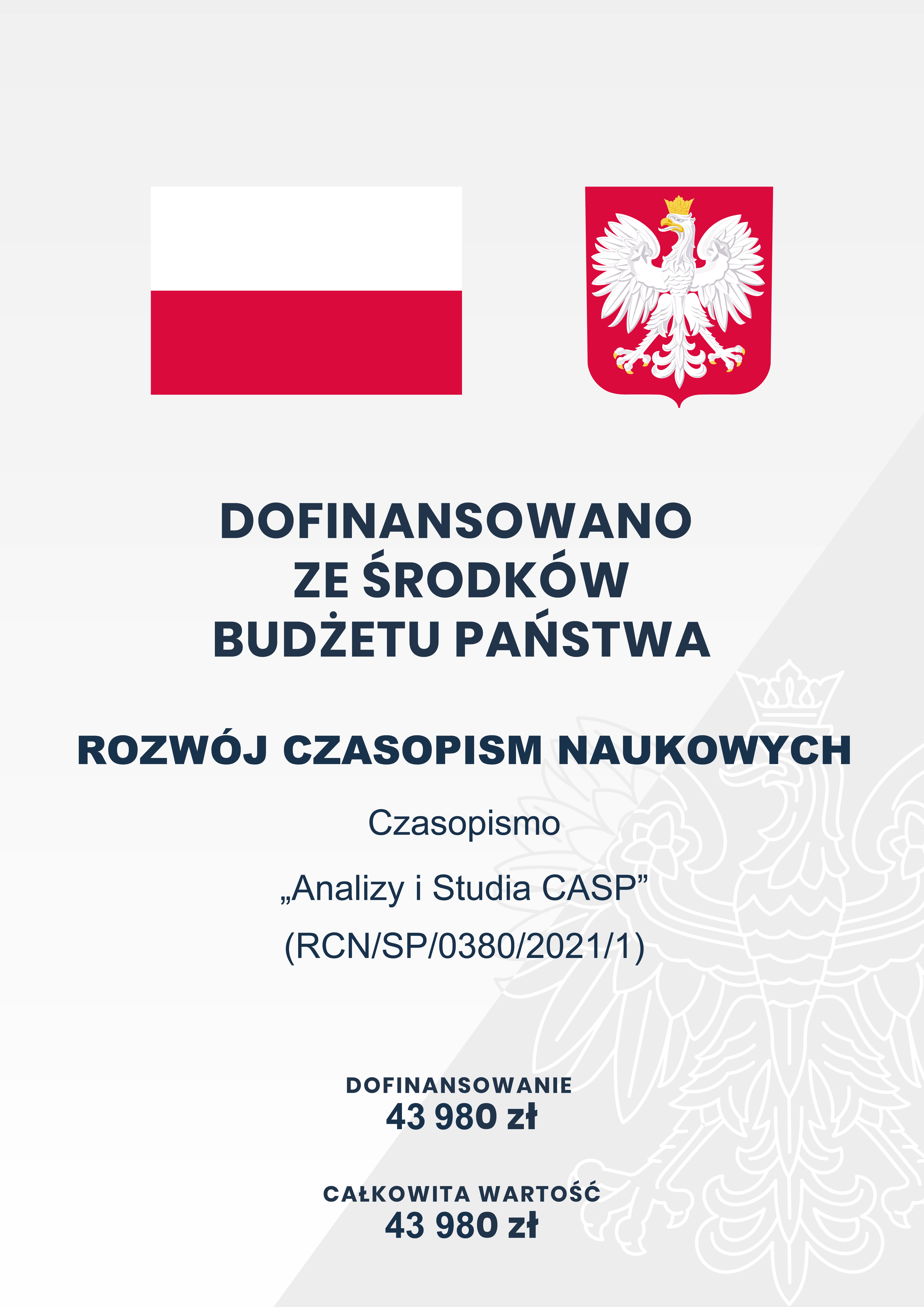Can Developing Countries Increase Foreign Investments by Sharing Their Taxation Rights
An Economic Analysis of Double Taxation Treaties between Countries in Asymmetric Investment Positions
DOI:
https://doi.org/10.33119/ASCASP.2022.2.2Keywords:
double taxation treaty, Foreign Direct Investment, gravity equation, international tax cooperation, developing countriesAbstract
This paper examines the effects of double taxation treaties on FDI inflows into both developing and developed countries. A gravity model equation was used to first estimate the general effect of the existence of a tax treaty between symmetric and asymmetric country pairs on FDI. Secondly, indices that indicate the proportion of source taxation rights negotiated in a tax treaty were employed in the same gravity equation as predictors. Both the conclusion of tax treaties in general and in particular those with a high share of source taxation were found to be negatively correlated with FDI inflows (–23.05%). A stronger effect could be estimated for FDI inflows into developing countries (–29.53%), indicating that developing countries face a more severe trade-off between the attraction of FDI from MNEs and the generation of tax revenue from business activities rendered in their territory.
References
Baier, F.J., & Welfens, P.J. (2018). BREXIT and Foreign Direct Investment: Key Issues and New Empirical Findings. International Journal of Financial Studies, 6, 46–67.
Baker, P.L. (2014). An Analysis of Double Taxation Treaties and their Effect on Foreign Direct Investment. International Journal of the Economics of Business, 21, 341–377.
Blonigen, B.A., & Davies, R.B. (2002). Do Bilateral Tax Treaties Promote Foreign Direct Investment? Working Paper 8834. NBER – National Bureau of Economic Research, https://www.nber.org/papers/w8834
Bobkova, B. (2012). Gravity model estimation using panel data – is logarithmic transformation advisable? Prague: Charles University in Prague.
CEPII (2021). CEPII – Gravity. CEPII. Research and Expertise on the World Economy, http://www.cepii.fr/CEPII/en/bdd_modele/presentation.asp?id=8
Coupe, T., Orlova, I., & Skiba, A. (2009). The Effect of Tax and Investment Treaties on Bilateral FDI Flows to Transition Economies. In: K. P. Sauvant, L.E. Sachs, The Effect of Treaties on Foreign Direct Investment: Bilateral Investment Treaties, Double Taxation Treaties, and Investment Flows (Chapter 24). New York: Oxford University Press.
Egger, P., Larch, M., Pfaffermayr, M., & Winner, H. (2006). The Impact of Endogenous Tax Treaties on Foreign Direct Investment: Theory and Evidence. The Canadian Journal of Economics, 39, 901–931.
Fischer, J. (2010). Accounting for Unobserved Country Heterogeneity in Happiness Research: Country Fixed Effects versus Region Fixed Effects (MPRA Paper No.22272). Munich Personal RePEc Archive, https://mpra.ub.uni-muenchen.de/22272/
Hearson, M. (2016). Measuring Tax Treaty Negotiation Outcomes: the ActionAid Tax Treaties Dataset. ICTD Working Paper 47. Brighton: Institute of Development Studies.
Hearson, M. (2018). When Do Developing Countries Negotiate Away their Corporate Tax Base? Journal of International Development (30), 233–255.
Hill, T.D., Davis, A.P., Roos, J., & French, M.T. (2020). Limitations of Fixed-Effects. Sociological Perspectives, Vol. 63, 357–369.
ICTD (2020). Tax Treaties Explorer – Data and Documentation. International Centre for Tax and Development (ICTD), https://www.treaties.tax/en/data/
Kaufmann, D., & Kraay, A. (2020). Worldwide Governance Indicators, info.worldbank.org, http://info.worldbank.org/governance/wgi/
Lejour, A. (2014). The Foreign Investment Effects of Tax Treaties. Working Paper. Oxford University Centre for Business Taxation – Working Paper Series, 14, 1–26.
Neumayer, E. (2007). Do Double Taxation Treaties Increase Foreign Direct Investment to Developing Countries? Journal of Development Studies, 43, 1501–1519.
Neumayer, E., & Barthel, F. (2012). Competing for Scarce Foreign Capital: Spatial Dependence in the Diffusion of Double Taxation Treaties. International Studies Quarterly, 56, 645–660.
OECD (2008). OECD Benchmark Definition of Foreign Direct Investment. Fourth Edition 2008. Paris: OECD. Retrieved from: Foreign Direct Investment Statistics. Explanatory Notes, https://www.oecd.org/daf/inv/FDI-statistics-explanatory-notes.pdf
Petkova, K., Stasio, A., & Zagler, M. (2020). On the Relevance of Double Tax Treaties. International Tax and Public Finance, 27, 575–605.
Quak, E.-J., & Timmis, H. (2018). Double Taxation Agreements and Developing Countries. Brighton: Institute of Development Studies.
Rixen, T. (2010). Bilateralism or multilateralism? The political economy of avoiding international double taxation. European Journal of International Relations, 16(4), 589–614.
Rixen, T., & Schwarz, P. (2009). Bargaining over the Avoidance of Double Taxation: Evidence from German Tax Treaties. FinanzArchiv, 65, 442–471.
Shepherd, B. (2016). The Gravity Model of International Trade: A User Guide (An updated version). Bangkok: United Nations Economic and Social Commission for Asia and the Pacific.
Silva, J.S., & Tenreyro, S. (2006). The Log of Gravity. The Review of Economics and Statistics, 66, 641–658.
Tenreyro, S., & Santos Silva, J. (2011). Further simulation evidence on the performance of the Poisson pseudomaximum likelihood estimator. Economics Letters, 112, 220–222.
UNCTAD (2021). United Nations. UNCTAD. Retrieved from: FDI/MNE Database – World Investment Report, www.unctad.org/fdistatistics
World Bank Group (2021). International Centre for Settlement of Investment Disputes (ICSID). Database of Bilateral Investment Treaties. World Bank Group, https://icsid.worldbank.org/resources/databases/bilateral-investment-treaties
Downloads
Published
How to Cite
Issue
Section
License
Authors retain copyright and grant the journal right of first publication with the work simultaneously licensed under a Creative Commons Attribution License that allows others to share the work with an acknowledgement of the work's authorship and initial publication in this journal. All authors agree for publishing their email adresses, affiliations and short bio statements with their articles during the submission process.
Author agrees to share his work under CC-BY-NC license.


























